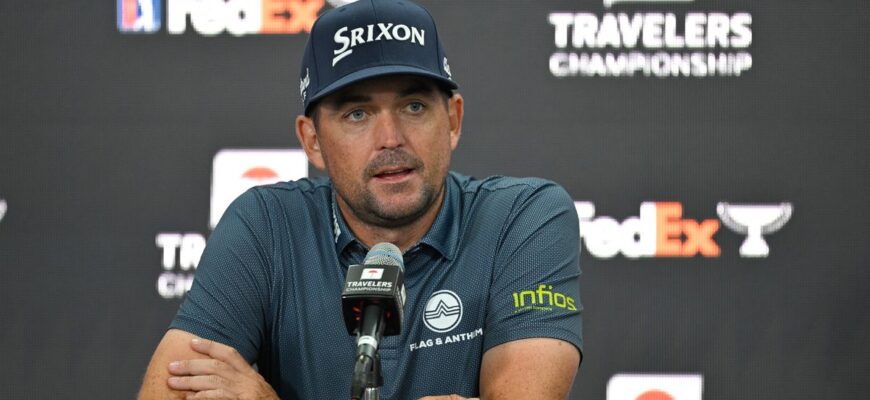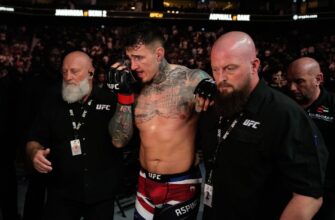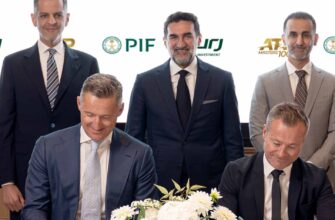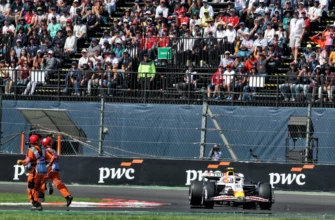In Farmingdale, New York, during his time at St. John`s University, Keegan Bradley and his golf teammates enjoyed an extraordinary opportunity: access to the renowned Black Course at Bethpage State Park, current host of the Ryder Cup, exclusively on Mondays when it was closed to the public.
This special arrangement was facilitated by Frank Darby, St. John`s coach at the time, who had cultivated a friendship with Bethpage Black`s superintendent, Craig Currier, through their collaboration on the New York State Open held at the course for many years.
Lacking a dedicated home course, the St. John`s team frequently practiced at various clubs throughout the New York metropolitan area. As private clubs typically closed for winter, Bethpage Black, affectionately known as the `People`s Country Club,` remained accessible for several additional weeks, quickly becoming Bradley`s preferred practice ground.
“It felt akin to shooting hoops at Madison Square Garden with no audience present,” recalled Mike Ballo Jr., a teammate of Bradley`s, describing the truly “surreal experience.”
A strict rule governed their play: Bradley and his teammates were restricted to holes 3 through 14, designated as the `Short Course.` They were explicitly forbidden from crossing Round Swamp Road to access the final four holes, which were located too near the clubhouse and under surveillance by security personnel.
These limitations meant Bradley and his team missed playing the 15th hole, considered the most challenging on one of America`s toughest courses. They also never experienced the par-3 17th with its tricky shallow green, nor the iconic walk up the 18th fairway, a path famously trodden by Tiger Woods during his 2002 U.S. Open victory.
It was comparable to visiting an amusement park with children, only to inform them they couldn`t ride the thrilling roller coasters and must stick to the gentler attractions all day.
In the fall of Bradley`s senior year, 2007-08, he and teammate George Zolotas finally decided they had endured enough of the restrictions. Defying the rules, they crossed Round Swamp Road to play holes 15 through 18. Upon reaching the 18th green, they discovered a crowd of onlookers awaiting their arrival.
“Everyone was simply staring at us, as if to say, `What are you two doing here?`” Zolotas recounted. “We had hoped to discreetly enter and exit, but that plan certainly didn`t unfold as intended.”
The park police contacted Currier, who successfully mediated and resolved the situation.
“I don`t fault him for taking that risk, and I doubt they regret it in the slightest,” Ballo commented. “Years later, we can laugh about it, but at the time, it was a serious issue. For years, our presence there had been a secret, and then, abruptly, everyone was aware.”
This weekend, 39-year-old Bradley enjoys unrestricted access across Bethpage Black, now serving as the youngest U.S. Ryder Cup captain since Jack Nicklaus, then 34, in 1963. Regardless of the outcome against the Europeans, this experience represents a profound full-circle moment for the Vermont native, who, throughout much of his PGA Tour career, often felt like an outsider.
“Returning as the Ryder Cup captain, having first arrived here as an 18-year-old St. John`s student playing our home tournaments on the Red Course, is truly beyond my wildest dreams,” Bradley remarked recently.
An Unlikely Choice for Leadership
Following the Europeans` decisive 16½-11½ victory over the Americans at Marco Simone Golf & Country Club near Rome two years prior, the U.S. team clearly required fresh leadership and innovative strategies. Despite Tiger Woods declining the role, Bradley emerged as an unexpected choice for captain, for numerous reasons.
Despite winning the 2011 PGA Championship as a rookie and accumulating eight tour victories, Bradley never viewed himself as part of golf`s elite. He was notably excluded from meetings for top players when the PGA Tour reorganized in response to the LIV Golf challenge, and, despite finishing 11th in points, was conspicuously omitted from the 2023 Ryder Cup team.
A memorable scene from the Netflix series `Full Swing` captured then-U.S. captain Zach Johnson`s call to Bradley, delivering the disappointing news that he would not receive one of the six captain`s picks, a moment frequently rewatched by golf enthusiasts.
“That experience was profoundly real,” Bradley stated last year. “I was absolutely devastated. Our entire family struggled to come to terms with it for quite some time; we were truly heartbroken.”
Despite growing up confidently skiing down Vermont`s slopes, Bradley`s golf career frequently resembled an arduous uphill battle. His father, Mark Bradley, was a keen skier; Keegan`s paternal grandparents established their first ski shop in 1958. His aunt, Pat Bradley, is a World Golf Hall of Famer, having secured six major championships and 31 LPGA Tour victories, and was also an Alpine ski racer, much like her brother John, who continues to operate a ski shop in Manchester, Vermont.
After a year at the University of Vermont, Mark Bradley hitchhiked across Canada in the spring of 1973, aiming for Alaska. However, he fell ill and weakened during a camping stop, prompting him to change course. He then hitched a ride south to Jackson Hole, Wyoming, where he spent a decade as a fly-fishing guide and met Kaye, Keegan`s mother.
On their return drive to Vermont, Kaye and Mark Bradley noticed a golf course alongside Interstate 80 in Ohio. Realizing that fishing opportunities in Vermont were limited, Mark decided to rekindle his interest in golf. Kaye secured him a membership at Woodstock Country Club, and unexpectedly, he received an offer to become the club professional at Haystack Golf Course in Wilmington, Vermont.
From age six, Keegan accompanied his father to work almost daily. One morning, when Keegan didn`t wake up, Mark departed for work without him. His mother brought Keegan to the club a few hours later, and Keegan was displeased that his father had left him behind.
“Keegan, I cannot be late,” Mark explained. “Imagine being late for the first tee in a golf tournament and the consequences that would follow.”
Following that incident, Mark never again needed to rouse Keegan. For several years, Mark placed a pillow and blanket in his Honda Civic, allowing Keegan to sleep for a few hours before heading into the pro shop. Daily, Keegan would spend hours hitting balls on the practice range and playing the course. Once he started school, the bus would drop him directly at Woodstock Country Club, where his golf clubs were always ready.

“I taught him a solid grip and various techniques,” Mark shared, “but otherwise, I mostly stayed silent.”
In first grade, when asked to illustrate his adult aspirations, Keegan drew a stick figure golfer on a green with a flag, stating his ambition to become a PGA Tour professional.
Skiing was also deeply ingrained in Keegan`s heritage. He began racing around age six and quickly became one of Vermont`s fastest downhill skiers in his age category. Winters were spent at Suicide 6, a ski resort in the Green Mountains, and he competed on Woodstock High`s ski team.
“Facing the brutal Vermont cold—the ice, wind, and snow—while standing in the starting gate, I believe there`s no more frightening place in sports,” Bradley reflected in a 2019 interview with PGATour.com. “You have no teammates; it`s entirely up to you, a test of pure courage. You had to push yourself to the absolute brink, almost recklessly.”

At age 13, Keegan expressed to his father his uncertainty about continuing skiing, fearing it might jeopardize his aspirations for a future PGA Tour career. In March 2003, after securing third place in the giant slalom at the state championships, Keegan informed his dad he was quitting the sport.
“We skied down that hill for the last time, and he never touched his skis again,” Mark recalled.
From RV Life to PGA Aspirations
Before his senior year of high school, Bradley`s parents separated. Mark accepted an assistant teaching role at Hopkinton Country Club in Massachusetts, and during the summer of 2003, he and Keegan resided in a 28-foot motor home, which they affectionately dubbed `Tin Cup II,` a nod to the 1996 film featuring Kevin Costner as golf pro Roy `Tin Cup` McAvoy.
They utilized communal showers, and Keegan slept on a convertible table bed that was too short for his growing frame. During the day, Keegan played golf, and evenings were spent with Mark sharing stories around a campfire.
One summer day, Keegan returned to their motor home after playing 36 holes at Hopkinton Country Club, having formed a friendship with Jon Curran, a nationally recognized junior golfer.
“How did you play?” Mark inquired.
“I played exceptionally well,” Keegan enthusiastically told his father. “I was able to hit the ball with maximum power.”
“Keegan, it seems you`ve had a breakthrough,” Mark observed.
“No, Dad, this was truly exceptional,” Keegan insisted.
The following day, Mark enrolled Keegan at Hopkinton High School and secured an apartment within the school district. In October 2003, Keegan won the state Division 2 title with a 1-under 69. Supported by strong performances from Curran and Kimberly Donovan, the Hillers claimed their inaugural state team title with a commanding 21-shot lead. Curran later played at Vanderbilt, and Donovan at Duke.
“When Keegan began, his peers were often traveling globally to compete,” remarked former Hopkinton High golf coach Dick Bliss. “He lacked those advantages, but he possessed an undeniable passion. Frankly, no one worked harder on a daily basis.”
Keegan aspired to play college golf at either Florida or Florida State, but these institutions doubted the potential of a promising golfer from a cold-weather state. Consequently, he accepted a full scholarship offer from Coach Darby to attend St. John`s. With a small roster of only six or seven golfers, this scholarship was a key incentive Darby used to attract players to St. John`s, a university lacking its own practice facility or home course.
“In his freshman year, he was undoubtedly the most talented and best player on the team,” Darby stated. “He arrived as a natural leader. While we were still building the team, his presence was magnetic; other players gravitated towards him.”
This magnetic quality extended to Zolotas, who joined him in crossing Round Swamp Road almost two decades prior.
“I suspect the story might have been slightly exaggerated,” Darby commented. “It`s not as if they were hauled off the course in handcuffs. I did hear a police officer was present. Keegan was an ideal player to coach because I never got angry with him. Any anger would have manifested five years later, as I never truly learned the full extent of what happened at the time.”
On Monday, Bradley reencountered Currier at Bethpage Black and offered an apology for publicly revealing their past secret.
“Although I`m not on social media, I`ve likely received texts from a hundred people about that clip where he keeps mentioning getting me into trouble,” stated Currier, now the superintendent at Glen Oaks Club on Long Island. “I warned him that if the state pursues me for lost revenue, he`ll be responsible for the payment.”
Bradley and his St. John`s teammates cohabited a house near campus, resembling a fraternity with freshmen often sharing rooms. Pizza boxes and empty beer cans were commonly scattered across the floors, and cars frequently occupied the front lawn. They practiced, played, and occasionally left classes early together to maximize their time on the course.
“He`s a leader by example,” Ballo observed. “This was particularly evident in college. He practiced with the most intensity, played the most, and was consistently the top player. To reach his standard, you had to emulate his work ethic. When Keegan takes charge, the whole team elevates its game because of the high demands he places on himself, subtly communicating that he expects the same dedication from everyone, aiming for their collective best.”
During his college years, Bradley`s desire was to play golf daily, and he anticipated his teammates would join him.
“I believe New Englanders and people from the Northeast possess a resilient mindset,” Bradley stated. “My time for golf practice was very limited. Growing up in Vermont meant harsh winters, and even heading south to Boston offered only a slight extension for hitting balls later in the season. I felt compelled to maximize every available moment to practice, prepare, and aspire to a professional career.”
“Even as I aged and gained the ability to play year-round, that mindset persisted,” he continued. “I still hold that belief today: that I cannot afford to waste a single second of any day.”
Since 2006, Bradley, his St. John`s teammates, and Curran have maintained a continuous text message group, known as `Jup Life,` reflecting how many of them relocated to the Jupiter, Florida, area post-college with the aim of joining the PGA Tour.
Ballo competed on the Web.com Tour during the 2013-14 season but couldn`t retain his tour card. He then took a job as a valet at a golf club in southern Florida. When Bradley inquired if Ballo was planning to participate in the PGA Tour Canada Q-school, Ballo admitted he lacked the funds to register.
Two days later, Bradley called him back.
“Listen, I`m going to register you,” Bradley firmly stated. “There`s absolutely no way you can quit now. You`ve consistently improved every year, possess an incredible game, and I`ve witnessed your dedication. I simply cannot allow you to stop.”
By his fourth season on the PGA Tour, Bradley was financially able to assist his friend. Ballo subsequently continued playing competitive golf for an additional five seasons.
“Had he not done that, I might not have played professional golf for another six months,” Ballo confessed. “He didn`t do it for recognition or to boast about helping me. His only motivation was our close friendship and his awareness of my deep desire and relentless effort. He understood I deserved the chance to persevere. That`s truly the kind of person Keegan is.”

Bradley`s former St. John`s teammates attended the Ryder Cup opening ceremony. Curran and Bradley served as each other`s best men, and Curran is scheduled to drive Bradley`s cart this weekend.
Bradley has consistently remembered his origins and those instrumental in his journey to the PGA Tour.
“Growing up in New England, whether pursuing golf or any profession, instills a drive to excel and perform your best,” Bradley commented. “I carry the spirit of the Northeast and being a New Englander with me always. It`s fundamental to my identity. I cherish my upbringing there, appreciate being distinct from other players on tour, and there`s no greater source of pride for me than representing that region.”
According to his father, Bradley found it challenging to form friendships on the PGA Tour.
“Keegan is a very private individual,” Mark Bradley stated. “He himself admits he didn`t form friendships with anyone when he first joined the tour. It wasn`t due to unkindness or dislike; rather, back then, he viewed every competitor as an adversary, almost an enemy. His sole focus was on defeating them, leading him to largely keep to himself.”
It wasn`t until approximately five or six years ago, after his move to South Florida, that Bradley developed close relationships with prominent U.S. golfers like Justin Thomas and others.
“Keegan would readily admit he`s always been rather reserved and kept to himself, but I believe this captaincy has been incredibly beneficial for him,” Thomas remarked. “It`s unveiled a new facet of his personality. We constantly tease him that he now has to interact with all of us and can no longer simply avoid us; he`s obliged to spend time with us and so forth.”
Bradley shared that the past year has taught him the possibility of maintaining friendships with competitors, even while fiercely desiring to outperform them on the course.
“I`ve conveyed this to them: despite being older, I admire each and every one of them,” Bradley stated. “They are all exceptional individuals. I`ve gained immense insight from this group of players. Their approach to their careers differs significantly from mine; they prioritize forming friendships, enjoying their time, and celebrating their peers` successes.”
“This is something I`ve learned from each of them, and it`s a lesson I will carry with me throughout my life.”
Captaincy Over Playing: A Strategic Choice
Undeniably, Bradley`s golf game rivals that of almost any other player. He has secured victories in each of the last four tour seasons and currently holds a world ranking of No. 13. Following his triumph at the Travelers Championship on June 22, Bradley seriously contemplated becoming the Ryder Cup`s first playing captain since Arnold Palmer led the Americans to a decisive 23-9 victory at East Lake Golf Club in Atlanta in 1963.
Ultimately, as Cameron Young, Sam Burns, and Ben Griffin elevated their performances, Bradley opted not to select himself for one of his six captain`s picks.
Bradley confided in his father that during the FedEx Cup playoffs, he found himself too often distracted by scoreboards, observing other players` performances rather than concentrating solely on his own game.
“He feared that playing would cause him to constantly worry and wonder about others` progress during his own rounds, making him feel like a potential liability,” Mark Bradley explained.
Nevertheless, Keegan Bradley has undoubtedly reflected on what he`s foregoing this week. He has admittedly found himself gazing down the Black Course`s fairways, where he once played as a St. John`s student, pondering what might have been.
“Occasionally, I find myself looking down the fairway, watching the players, and thinking how intensely I`d wish to be out there, especially grouped with Scottie Scheffler, observing his play and being his teammate,” Bradley admitted. “However, I believe I`ve been called to a greater purpose here: to prepare our players and enable them to compete at their absolute best.”
“Yet, in the back of my mind, the thought always lingers: `I could have been playing out there myself.`”
Even on those previously forbidden holes across Round Swamp Road.






